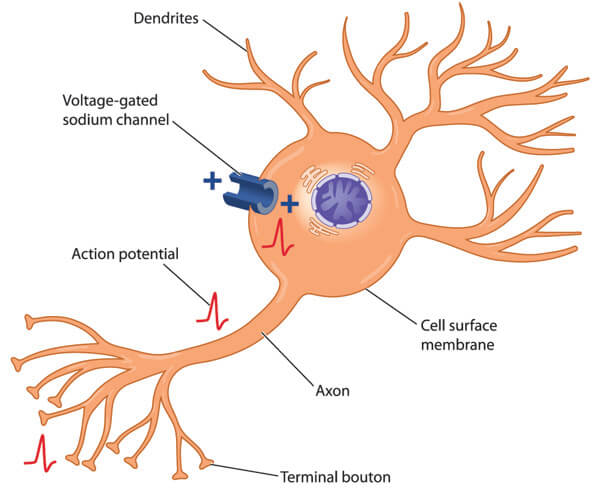The human brain is a marvel of complexity, composed of billions of neurons intricately interconnected to form the foundation of cognition, memory, perception, and behavior. These neurons communicate with each other through electrical signals known as action potentials. The refractory period is a crucial aspect of this communication process, playing a vital role in ensuring the precision and timing of neural firing. This article delves into the concept of the refractory period in neurons, its different phases, underlying mechanisms, and its significance in neural information processing.
What is the Refractory Period?
The refractory period refers to a brief period following an action potential during which a neuron becomes temporarily unresponsive to further incoming stimuli. It is a fundamental characteristic of neural firing and ensures that neurons transmit signals in a controlled and synchronized manner. The refractory period is critical for preventing excessive excitation and maintaining the integrity of neural circuits.
Phases of the Refractory Period
The refractory period can be divided into two main phases: the absolute refractory period and the relative refractory period.
A. Absolute Refractory Period:
The absolute refractory period is the initial phase of the refractory period during which a neuron is completely unresponsive to any incoming stimuli, regardless of its strength. This phase occurs immediately after an action potential and is primarily due to the activation of voltage-gated sodium channels.
During an action potential, the membrane potential of the neuron rapidly depolarizes, leading to the opening of voltage-gated sodium channels. These channels allow a significant influx of sodium ions, causing a rapid increase in membrane potential. As the membrane potential reaches a critical threshold, it triggers the opening of potassium channels, leading to the repolarization of the neuron.
However, during the absolute refractory period, the voltage-gated sodium channels remain inactivated and cannot be reopened, preventing the generation of new action potentials. This ensures that the neuron cannot fire again until it has fully repolarized.
B. Relative Refractory Period:
Following the absolute refractory period, there is a phase called the relative refractory period. During this phase, a neuron can fire again in response to a strong stimulus, but the threshold for firing is higher than usual. This increased threshold is due to the gradual recovery of voltage-gated sodium channels from their inactivated state.
The relative refractory period allows for the possibility of firing additional action potentials, but it requires a stronger stimulus to overcome the heightened threshold. The relative refractory period is vital for controlling the frequency and pattern of neural firing, ensuring the temporal precision of information processing in the brain.
Mechanisms Underlying the Refractory Period
The refractory period is mainly regulated by the dynamic interplay of various ion channels and their gating properties.
A. Voltage-Gated Sodium Channels:
During the absolute refractory period, voltage-gated sodium channels are inactivated, rendering them incapable of reopening. This inactivation is crucial for preventing the immediate generation of another action potential, as it ensures a brief period of neural rest and recovery.
B. Voltage-Gated Potassium Channels:
After the opening of voltage-gated sodium channels during an action potential, voltage-gated potassium channels play a pivotal role in the repolarization of the neuron. These channels allow the efflux of potassium ions, restoring the membrane potential to its resting state.
C. Ion Concentration Gradient:
The restoration of the neuron’s resting potential relies on the active transport of ions by the sodium-potassium pump. This pump actively transports three sodium ions out of the neuron while simultaneously moving two potassium ions inside. This process re-establishes the ion concentration gradients necessary for the neuron to respond to incoming stimuli again.
D. Membrane Capacitance:
During the refractory period, the membrane capacitance, which represents the ability of the neuron’s membrane to store electrical charge, is temporarily reduced. This reduced capacitance further contributes to the neuron’s unresponsiveness during the refractory period.
Significance of the Refractory Period in Neural Information Processing
The refractory period is a crucial mechanism that underlies various aspects of neural information processing:
A. Temporal Coding:
Neurons communicate through precise timing, and the refractory period ensures that action potentials are temporally separated. This temporal coding enables the brain to encode and process complex information efficiently, leading to accurate and rapid decision-making.
B. Preventing Signal Saturation:
The refractory period prevents neurons from firing in quick succession, which could otherwise lead to signal saturation and excessive neural activity. This mechanism is essential for preventing hyperexcitability and maintaining the stability of neural circuits.
C. Frequency Modulation:
By adjusting the frequency of action potentials, neurons can convey different types of information. The relative refractory period allows neurons to fire at varying rates, enabling them to transmit information in a graded manner.
D. Synchronization:
The refractory period also plays a role in synchronizing the activity of interconnected neurons. The precise timing of action potentials helps in coordinating the activities of different brain regions, which is critical for various cognitive processes.
Conclusion
The refractory period in neurons is a fascinating and essential aspect of neural communication. It ensures the precision and accuracy of information processing, prevents excessive excitation, and allows for the synchronized functioning of neural circuits. Understanding the mechanisms and significance of the refractory period provides valuable insights into the intricate workings of the brain and paves the way for advancements in neuroscience and brain-related disorders. Further research in this area promises to unlock even more mysteries of the human brain, contributing to the betterment of human health and cognitive understanding.

